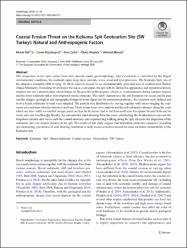Coastal Erosion Threat on the Kizkumu Spit Geotourism Site (SW Turkey): Natural and Anthropogenic Factors
Abstract
The uniqueness of the spits comes from their special coastal geomorphology. Spit's evolution is controlled by the fragile environmental conditions, the sediment input, long shore currents, wave, wind and river processes. The Kizkumu Spit, one of the attractive examples (400 m long; 18-48 m wide) is located in an environmentally protected area in southwestern Turkey (Datca-Marmaris). Extending 50 cm below the sea as a red carpet, the spit with its distinctive appearance and mysterious history enhance the site's attractiveness which brings on the possible anthropogenic effects as overpopulation during summer tourism and the lower sediment influx from improper marine structure. This study characterizes the spit formation via recent and the past satellite images, geological and topographical maps to better figure out the protection pathways. Six locations were defined and twelve beach sediments in total were sampled. The particle size distribution by sieving together with micro-imaging the sediments are combined with the statistical analyses. Mode values from sieve analysis and the red-coloured sediments along the coast which are also visible on satellite images point out that the Kizkumu Spit is fed from north (via Kocapinar Stream Delta and its coast) and east (via Bozegri Brook). An uncontrolled sand-drawing from the coast, establishing the breakwaters to prevent the longshore currents and waves onto the coastal structures and experiencing walking along the spit, all cause the dispersion of the sediments and very intense erosion on the spit. The results of this study suggest that immediate protection measures (including spit-monitoring, prevention of sand drawing, limitation of daily tourist activities) should be taken for future sustainability of the Kizkumu spit.


















